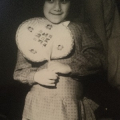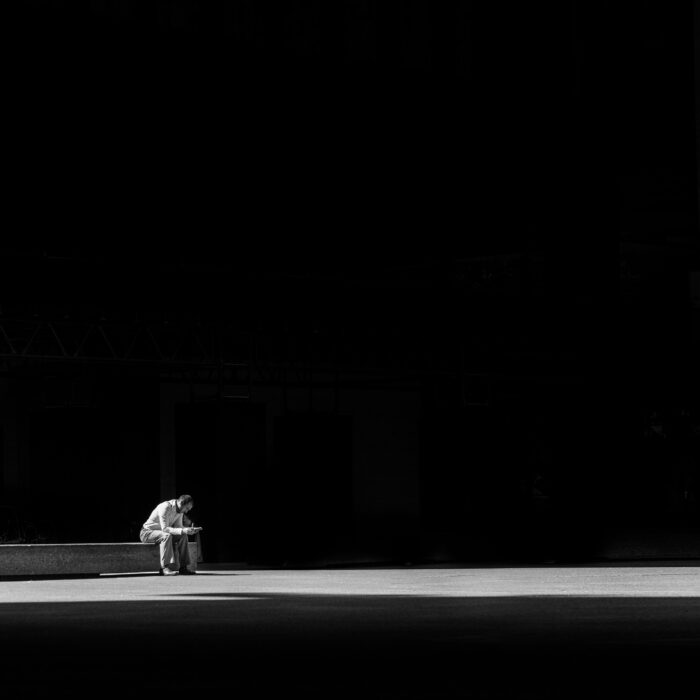You have no items in your cart. Want to get some nice things?
Go shopping
…neither the term Orient nor the concept of the West has any ontological stability; each is made up of human effort, partly affirmation, partly identification of the Other.
Edward W. Säid, Orientalism
…When we reflect on the vast diversity of the plants and animals which have been cultivated, and which have varied during all ages under the most different climates and treatment, I think we are driven to conclude that this great variability is simply due to our domestic productions having been raised under conditions of life not so uniform as, and somewhat different from, those to which the parent-species have been exposed under nature.
Charles Darwin, The Origin of the Species
A monastery garden in Rangoon, Burma, 1948.
A frayed red ribbon in a pocket. Small, nimble fingers turn the ribbon over and over.
A fair-haired boy of about twelve years old is looking through a thicket of foliage and branches. His bowed head, framed by a crown of yellowing leaves burnt by the sun, shudders a little as he arches his back and stretches his bare feet over the flaking trunk of a tree; he climbs high into its branches, light and dust particles shimmering at the periphery of his vision. He moves slowly, dodging the glare of sunlight. He slips a hand into the wiry branches of the tree, angling himself so that his entire body is taut and narrow in the canopy of foliage. He clasps his fingers around a small object at the outermost edge of the branches: a perfect mango tied with a red ribbon. He draws his hand towards himself, slowly, cupping the mango. For a moment, the boy holds the mango instinctively to his nose, its skin just touching his upper lip. He cradles the mango in his shirt pocket and then drops down, lightly, patting the parched earth with his unfurling limbs, steadying himself as if the entire weight of the fruit had tipped the scales of his body, unbalancing his being.
The boy takes out the mango from his pocket and unties the sacred gesture of the ribbon. Light settles over the thin skin of the fruit and reveals a beautiful patina of pink, yellow and amber. Somewhere higher up in the trees, bronze-winged Jacana birds and bulbuls steady swaying branches. The boy presses the fingernail of his thumb down on the resistant epidermis of the fruit, dimpling the ripe fruit.
Another person might have stored up this memory of the colours, the weight of the fruit in the palm of the hand, but all this has evaded the sensibilities of the boy. Right now, the boy is thinking about hunger.
A few nights ago, the boy’s uncle had stood at their veranda with a drink in his hand. He spoke softly, as if he were removing a spider from its web.
“Without a knife, it is difficult to peel the flesh of a mango. One can push into its flesh and scratch it with fingernails, but a sharp object is always required. Ripe mangoes are easier to tear; they yield, with patience, to the uneven surface of stones. Hunger invites improvisation.”
The boy works the fruit with a knife and turns its skin inside out so that it resembles a three-dimensional tortoise shell. Messily, he rips into the skin of the fruit.
Accompanying the sense of hunger that has brought the boy to the orchard is a small, anonymous feeling of joy. This buoyant feeling is vaguely familiar to the boy, but long since forgotten until now. The only thing the boy does know is that the fruit is a symbol; he knows this because of the red ribbon in his pocket. The boy realises, now, that he is also a kind of symbol. He knows this because he has eaten the fruit.
The monks that tended the mango orchard had not counted on this particular boy’s lack of interest in authority, or ritual. The ribbons were a warning, a threat to the mortality of any human interested in eating the precious fruit that they had adorned, but the boy had felt the threat of death before, many times in fact, it held no power over him. He had grown to become familiar with his own personal set of symptoms which amounted to fear: the rumble in his chest like icy hands turning inside his ribcage, the sudden lack of saliva in his mouth, the hairs standing on end just behind the back of his (unusually) small ears.
It occurred to the boy that a strange immunity from fear now plagued him. It had first approached him gently, whispering into his ear at night, tempting him to patrol the house at midnight, hold his breath in the depths of the outdoor swimming pool, and then it led him towards more risky endeavours, lingering towards the edge of the tracks at the train station, jumping over neighbour’s fences and worrying their ravenous guard dogs. Recently he had taken to climbing trees.
Seconds, minutes pass, but there are ribbons, still, in the boy’s pocket.
Sloping down the back of his throat, another piece of mango flesh sinks into the pit of the boy’s stomach. Then, just as quickly as the feeling of hunger had arrived, his eyes search beyond the ruins of a wall. His gaze traces the contours of a courtyard where several other children are playing. The boy drops the ribbons and heads towards the shade of the stone cloisters. He runs, feet pounding against the dry earth, mud fissuring under the summer sun. The boy’s thoughts turn towards afternoon tea, arrowroot biscuits and jaggery, the slabs of golden, raw cane sugar sold by street wallahs in cellophane jackets.
Just as he turns on his heels, the boy senses the mango inside his stomach and imagines it there, curdling with this morning’s milky chai and porridge. A momentary stomach ache rouses his suspicions, unsettling his nervous system. Now, the red ribbons feel as if they are burning a hole in the boy’s pockets. He brushes a feverish hand across his face and he hears himself make a noise similar to twigs snapping, a snatch of shallow laughter.
If what the monks say is true, the boy thinks, then I am dead now and I am a ghost running towards my friends. If what the monks say is true, then I will soon turn to stone, like the ruins of the walls of the city, like the monument to Queen Victoria in the botanical gardens. My skin will always to cool and I will be still and silent, while others breathe on my frozen face. Or, I will be a ghost, haunting this spot forever.
He is suddenly aware of the fading, warm sunlight on his skin, the wind in the trees. In this short moment, the boy contemplates the sudden speed of his breathing, the feeling of air rushing through his lungs. As the boy enters the shadows of the courtyard, a question nudges him:
Do ghosts breathe?
Then, someone in the distant courtyard catches the boy’s eye and smiles. Another child, smaller and with long, dark hair tags the boy, tapping his shoulder. The boy is relieved at the evidence, the contact which must mean that he is not a ghost; even more delicious that the fruit itself, he calculates, is the thought that the threat of death is vanquished.
He does not know why he does this, but he points to the mango trees in the garden and dares the others to eat the fruit, taunting them, grinning, bragging.
Later, piles of ribbons are scattered throughout the monastery garden. A boy’s hunger has undone centuries of tradition.
*
Years on, the boy will think about the mangoes again when his daughter is all grown up and he is seven decades old and dying of cancer. He will know that his lungs are failing and he is unable to cease the muddling of time and space, the drifting through little corners of his unconscious. Waking moments are filled with snatches of gauzy vignettes fuelled by morphine. Childhood memories swim up inside him like protective armour, luring him into shallow sensations.
Armoured, he whispers: “Do ghosts breathe?”
He enters the drift again: light breaks through branches and curling leaves. A small hand pushes back the foliage and touches the mottled, mossy bark of a tree. Somewhere else, a figure turns in a metal-framed bed, dreaming of the weight of water against his body, a dream of swimming in India.
*
My father fell ill while I was writing my PhD in London. My husband and I were living with my parents in Hayes, Hillingdon, in their modest house on a street with a chemist and a petrol station at the end of it. It started when my father became very restless at night, up in the early hours of the morning in his armchair. Then, everything just slowed down.
We decided to move out of the house and I found myself leaving for a rural destination, packing books into supermarket boxes and rucksacks. As his only child, it was my responsibility to care for my father, but it felt better somehow to enter the orbit of his existence as a visitor from a slightly separated world. My mother would care for my father, and we would visit. I deliberately started to force a gap between life inside the house in Hillingdon and the life my husband and I were belatedly beginning together, after six years of living with my parents. Of course, I had not expected the end of that life with my parents to be so abrupt, but I should have known that it was never going to be easy.
My father had told me a story about his climbing up into the mango trees while he was a schoolboy in Rangoon, soon after the war had ended and the Japanese had retreated from their occupation of Burma. He had been a prisoner of war as a very young child and had experienced most of those fraught years in Burma under house arrest, while my grandfather was ordered to retain his responsibilities as the chief of the Burmah Oil Company. My father was largely silent on the subject of his internment during the war; he talked about the latter part of his childhood with extra emphasis on nostalgic tales of school life, friends he had made, cricket matches and the food he had eaten. But the trauma of his internment crept into daily life, it was quietly there, like ivy twisting its way through a hedge. Most revealing were his agoraphobic tendencies, which he never acknowledged; he preferred to stay indoors and he enjoyed the safety of routines.
After the war, school days began again, but the picking of the sacred fruit led to my father’s expulsion from the local monastery and he was immediately sent to an American boarding school in Darjeeling, a last resort which became his cherished paradise. The eating of the mangoes seemed to take on a magical significance, granting my father wishes rather than bringing about any kind of curse of death. In England, so many years later, I wished he could vanquish death again and prove that the cancerous cells dividing inside his body were just a collective, benign threat just like the ribbons tied around the mangoes by the monks in Burma.
*
We decided to move nearer to where my husband worked as a music teacher in the Home Counties. I was still a student so our budget was small. I found a surprisingly cheap, small studio flat in a large house on an estate; it had a stream with trout in it, gated walls, a marble fireplace in a communal room and a roof terrace overlooking ancient oaks and drifts of conifers bordering agricultural fields. Although our flat was in the cramped eaves of the house and its windows were too high to see out of, I felt I had found a good place to work and, really, its magical beauty brought some momentary happiness. I have since come to think that the experience of a place can change, unsettle, the balance of emotion, thought and time, even, especially if it is encountered at the right moment. I had thought my identity was rooted in the place I grew up in, but now I know how ambivalent those threads are that connect us to the exterior world.
My father was Anglo-Burmese, with a complicated ancestral heritage. While his paternal grandparents had left Coulmain, County Clare in Southern Ireland in 1885 for India via Nepal, his maternal grandparents were an unusual coupling of Austrian and Shan lineage, an ethnic minority referring to the Hill people settled on the borders of Burma, Laos, Thailand and China. (Shan people are pale, unlike the olive-skinned Burmese, they are known for their basket-weaving skills and climbing prowess). While my father had been born in Rangoon in the late thirties, he had also lived in England most of his life, arriving at the age of eighteen in the mid-fifties. He had worked at a factory in Southend on Sea before settling in West London. But home was always Darjeeling, the paradise-school. It was always in his pocket when he left for work, or turned the pages of a newspaper.
We lived in many different houses as I was growing up and I think that my father’s troubled sense of displacement, homesickness and his inability to really feel at ease in England was linked directly to his desire to keep moving; it was only when I was around ten years old that we settled and he began to busy himself with painting and minor renovations.
Yet, if there was a compass point, a destination with which all coordinates in my father’s life were pointed towards, then it was his sister’s simple oblong dining table in her Ealing semi, positioned just in front of the boiler in the crimson-coloured chimney breast. We had all sat around that table and watched my aunt move between the galley kitchen and the dining room, serving tea out and ham sandwiches. Always, at the edge of the table was a glass pirex dish with a strange combination of Anglo-Indian and Burmese food my aunt had prepared from recipes her mother had left her; Sanwihn Makkin (pronounced sinna-makin), a Burmese semolina cake made with bananas and cardamom, Country Capon, a chicken curry made with saffron, or mince pasties (pustols) and stuffed aubergines (brinjal bake). My favourite was the Sanwihn Makkin and its dense, rich squares of slippery, pale banana flavoured semolina. My aunt’s apron was always stained with saffron and her hands were often scented with lemon.
My aunt was ten years older than my father and when she married at the age of twenty-one in Calcutta, my father went to live with her during the school holidays. My aunt and uncle had forged a surrogate parental bond with my father after he became ill with typhoid fever. My uncle’s wages as an engineer at the Shalimar Paint Company meant that he could afford my father’s medication. The arrangement of the table and the furniture in my aunt’s house must have comforted my father, recalling the configuration of homeliness in Calcutta and reminding him of the love of his sister and brother-in-law which saved his life.
*
It was a bizarre thing to move from London to the old house with the stream; I had never lived outside of Hillingdon, an industrial county with arterial roads bisecting strips of factory buildings, gas towers and retail parks. Suddenly I was learning about hedgerows, shooting seasons, village politics. I could walk to the village shop and I would not meet a single person. This rural England, the England I had read about in books like Ronald Blythe’s Akenfield and the nostalgia of L.P. Hartley’s The Go-Between and Evelyn Waugh’s Brideshead Revisited, was entering my life sideways, across the vertical constant that was my family and, back then, the writing of my PhD. I began to think about the journeys my own family had taken, and the routes they took, crossings which encompassed southern Ireland and Nepal, Calcutta to Rangoon, and the most significant one for both my parents, Rangoon to England by boat via Egypt. England was, for them, the Royal family, Earl Grey tea, Marks and Spencer woollen blankets and Imperial Leather soap. The greenness of England and its rural palette of auburn and dirty emerald hues must have been a shock for my family as they peered through train carriage windows on their way from Portsmouth Harbour to London. They would have seen trees continually sodden with peripatetic sheets of rain, mud irritatingly clumping under patent leather shoes.
Before we had left Hillingdon, my own notion of the English countryside was only felt as a residual or fleeting presence, either suggested through the appearance of my husband’s shabby wellington boots, incongruous in the local, carpeted pub in suburban Hayes, or as a flattened image behind the windscreen of our car when I accompanied my husband to work sometimes, reading about semiotics and psychoanalysis in a school car park. Now the mud was on my boots, I was in that place he had often disappeared to and I had become a new figure in the landscape of his world, even though we had lived together for years.
An England very different to the suburban one he had experienced for the past five decades, entered my father’s everyday routines through my discussion of trees, animals and fields while he drank tea, played with the dog and shared the television remote control with my mother. I would tell my father about the pheasants I had seen nearly run over, as if they were alien entities, found objects. I described the shape of the bricks in the building I lived in, the stained glass in the Saxon chapel. My father listened. Of course, he already knew about sacred ruins, and trees, and fowl, he had experienced nature and all kinds of pastoral vistas as a child, not as exotic pleasures, but as the very fabric of life in Burma and India. We talked about the birds I had seen.
One morning, I saw my father looking out at our garden from his chair. He had turned his entire body so that he could see without getting up. A sparrow had circled the garden path and was resting by our plum tree.
“What are you looking at?” I asked.
“That bird over there. It looks just like a bulbul.”
“A what?”
“You see them in India.”
The Oxford Handbook of the Birds of India and Pakistan (1996) describes the bulbul as a small bird belonging to the Pycnonotidae family. They have long, notched tails and they can appear in colourful variations of olive-brown, yellow or brown to black. They are songbirds, keen on lively harmonies. A.L. Lintoch’s entry in the 1922 edition of The Journal of the Bombay Natural History Society describes the discovery of bulbul bird eggs in the Nelliampathy Hills, Kerala, comparing his notes with the writings of the Victorian naturalist Frank Oates. The bulbuls, or Otocompsa emeria fuscicaudata, had laid eggs in a coffee tree during December, a month not usually associated with the bulbul’s mating season, according to Mr. Oate’s Fauna of British India, including Ceylon and Burma (1889). Lintoch writes excitedly about his discovery of the bulbuls in Nelliampathy, commenting on the sizes of their eggs and the frequency with which they have been laid. The birds nest in the hills, returning in November; the migration habits of the bulbuls seems unpredictable, but then they are songbirds, as Oates also notes, they make musical sense out of the strangeness of the new.

About Davina Quinlivan
Davina Quinlivan is a UK-based writer and academic. She is author of several academic books including 'The Place of Breath in Cinema' (EUP, 2014) and 'The Spirit of the Beehive' for the BFI Modern Classics series (Bloomsbury, forthcoming). Her creative writing and journalism has featured in Cleo, Lola, The Times Higher culture section, Another Mag, Dazed Digital, Little White Lies and Litro. She is developing a memoir/ nature writing about moving to rural England after her father's death from lung cancer and her post-colonial, South East Asian heritage.



